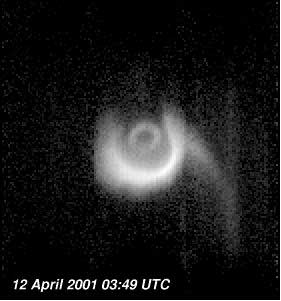Polar Resurrects TIMAS, Immediately Detects New Terrestrial Ion Signature
On Oct 29, 1999, all telemetry reported from TIMAS became invalid (zeroes). Thereafter, collection of valid values was sporadic, ending on July 15, 2000. The fault appeared to be located at the interface between TIMAS and the GGS Telemetry Module 1 (GTM1) and was loosely temperature dependent. On Mar 27, 2001 the Polar spacecraft switched to its backup telemetry module and restored telemetry capture of the TIMAS mid-energy mass spectrometer. TIMAS immediately detected new terrestrial source ion signature at the dayside magnetosphere during magnetic storm period.
Polar's orbit has precessed so that it samples regions near the dayside equatorial magnetopause with high-temporal and spatial resolution the low-latitude boundary layer, turbulent boundary layer, magnetosphere, and magnetosheath.

- TIMAS energy-time spectrogram obtained as Polar passed through the polar cap, cusp and dayside magnetosphere.
- Obtained shortly after the onset of the large magnetic storm on 3/31/2001, these data show intense ionosphere O+ flowing at high altitudes well equatorward of the cusp.
- The free energy to drive these ions to such high altitudes on the dayside appears to be related to large scale electric fields generated during the storm period.
Other Polar Particle Detectors Report Similar Observations
TIDE low-energy ion data, from a similar orbit, clearly demonstrate the presence of the terrestrial source ions within the turbulent boundary layer.Within this layer, circularly polarized waves accelerate the plasmaspheric-like ions to 30-40 km/s perpendicular to B.
New Dayside LLBL Observations Define Path for Circulation of Terrestrial Particles
Interpretation and Implications:
 Based on density ratios and low field-aligned drifts, the plasma is of plasmaspheric origin.
Based on density ratios and low field-aligned drifts, the plasma is of plasmaspheric origin.- Likely to be associated with plasma tails observed by IMAGE that show a convection path for plasmaspheric ions to the magnetopause.
- Polar flies through the region of emission seen by IMAGE:
- provides composition and absolute density for observations
- quantifies source strength
- determines plasma processes for the transport of plasmaspheric ions to the plasma sheet - a source that had been proposed but not directly observed until IMAGE imaged the "path" and Polar observed the entry into the boundary layer.
- provides composition and absolute density for observations
Click to download PowerPoint Presentation.
Comments/Questions/Suggestions: Webmaster
Official NASA Contact:
NASA Official: Adam Szabo
Curators: Robert Candey,
Alex Young, Tamara Kovalick
NASA Privacy, Security, Notices

